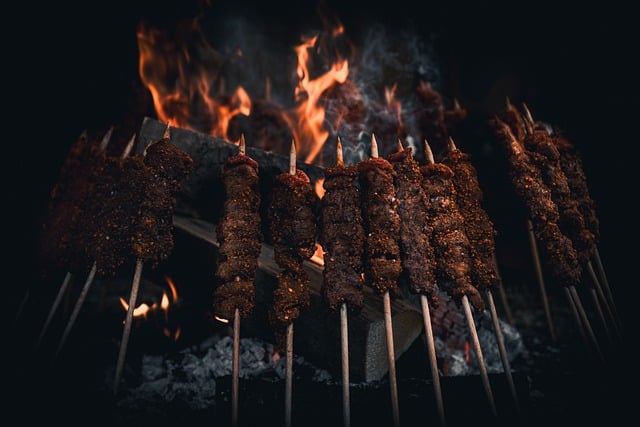Sizzling Secrets: The Art of Charcoal Grilling
Ignite your taste buds and master the primal dance of fire and food. Charcoal grilling isn't just cooking; it's a sensory adventure that transforms simple ingredients into smoky masterpieces. From selecting the perfect charcoal to mastering temperature control, this guide will elevate your outdoor cooking game and turn your backyard into a gastronomic wonderland.

Unlike gas grills, charcoal imparts a unique flavor profile to food. The high heat creates a perfect sear on meats, locking in juices and creating a crispy exterior. The smoke produced by burning charcoal infuses food with complex flavors that simply can’t be replicated with other cooking methods. Moreover, the ritual of lighting the charcoal, arranging it in the grill, and tending to the fire adds an element of mindfulness to the cooking process, making it as much about the journey as it is about the destination.
Choosing Your Charcoal
Not all charcoal is created equal, and selecting the right type can make a significant difference in your grilling experience. There are two main types of charcoal: lump charcoal and briquettes. Lump charcoal is made from pure hardwood and burns hotter and faster than briquettes. It produces less ash and imparts a cleaner, more subtle smoky flavor to food. On the other hand, briquettes are more uniform in shape and size, burn more consistently, and are often more affordable.
When choosing charcoal, consider factors such as burn time, heat output, and flavor profile. For quick-cooking items like burgers or vegetables, lump charcoal’s high heat and short burn time may be ideal. For longer cooking sessions, such as smoking a brisket, briquettes’ steady burn and consistent temperature might be more suitable. Experiment with different types and brands to find the charcoal that best suits your grilling style and flavor preferences.
Mastering Temperature Control
One of the most crucial skills in charcoal grilling is temperature control. Unlike gas grills with adjustable knobs, charcoal grills require a more hands-on approach to maintain the desired cooking temperature. The key lies in understanding how to arrange your charcoal and manipulate airflow.
Start by creating different heat zones in your grill. For a two-zone fire, pile most of the lit charcoal on one side of the grill, leaving the other side empty. This creates a hot zone for searing and a cooler zone for indirect cooking. To control temperature, adjust the vents on your grill. Opening the vents allows more oxygen to flow, increasing heat, while closing them reduces oxygen and lowers the temperature. Use a grill thermometer to monitor the temperature accurately, and don’t be afraid to add or remove charcoal as needed to maintain your desired heat level.
The Art of Smoke
Smoke is the secret ingredient that gives charcoal-grilled food its distinctive flavor. While the charcoal itself produces some smoke, adding wood chunks or chips can elevate your grilling game to new heights. Different woods impart different flavors, allowing you to customize your cooking experience.
For a classic barbecue flavor, try hickory or mesquite. For a milder, sweeter smoke, opt for fruitwoods like apple or cherry. Experiment with different combinations to find your perfect smoke profile. Soak wood chips in water for about 30 minutes before use to prevent them from burning too quickly. For longer smoking sessions, use larger wood chunks that will smolder slowly, releasing smoke over an extended period.
Beyond the Basics: Advanced Techniques
Once you’ve mastered the fundamentals of charcoal grilling, it’s time to explore more advanced techniques. One such method is reverse searing, where you start by cooking meat at a low temperature over indirect heat, then finish it with a quick sear over high heat. This technique results in perfectly cooked meat with a beautiful crust.
Another advanced technique is plank grilling, where you cook food on a water-soaked wooden plank. This not only imparts additional smoky flavor but also keeps delicate foods like fish from sticking to the grill grates. For the adventurous griller, try incorporating a cast-iron skillet into your charcoal grilling repertoire. It’s perfect for creating crispy-edged smash burgers or caramelizing vegetables while still capturing that smoky essence.
Grilling Pro Tips
• Always preheat your grill for at least 15 minutes before cooking.
• Use a chimney starter for quick and easy charcoal lighting without lighter fluid.
• Keep your grill grates clean and oiled to prevent sticking.
• Let meats rest after grilling to allow juices to redistribute.
• Experiment with different rubs and marinades to enhance flavors.
• Use a meat thermometer to ensure food safety and optimal doneness.
• Don’t forget to grill fruits and vegetables for a well-rounded meal.
Charcoal grilling is more than just a cooking method; it’s a culinary adventure that engages all your senses. By mastering the art of charcoal grilling, you’ll not only create incredible meals but also craft unforgettable experiences around the grill. So fire up that charcoal, embrace the smoke, and let your inner grill master shine. Your taste buds—and your guests—will thank you.




